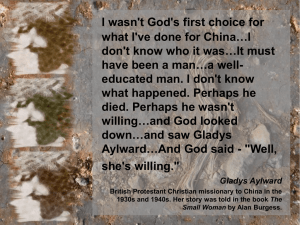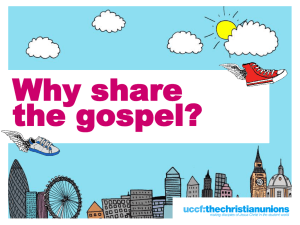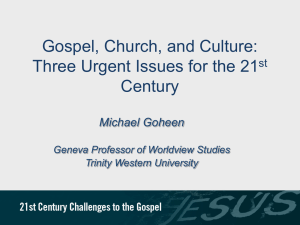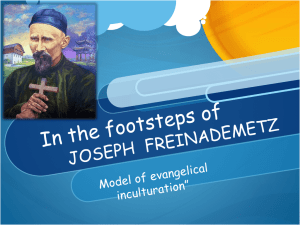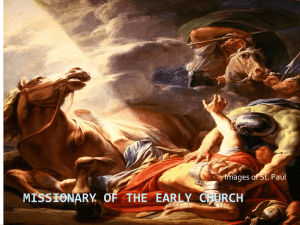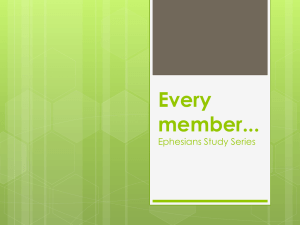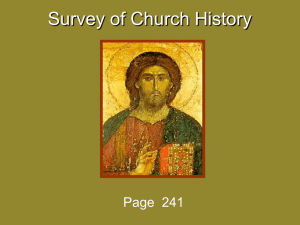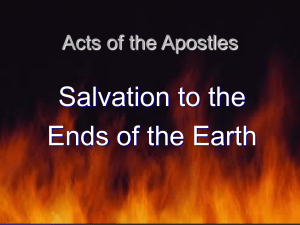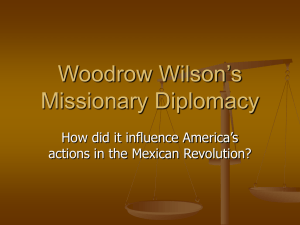Kristin F. Tjelle
advertisement
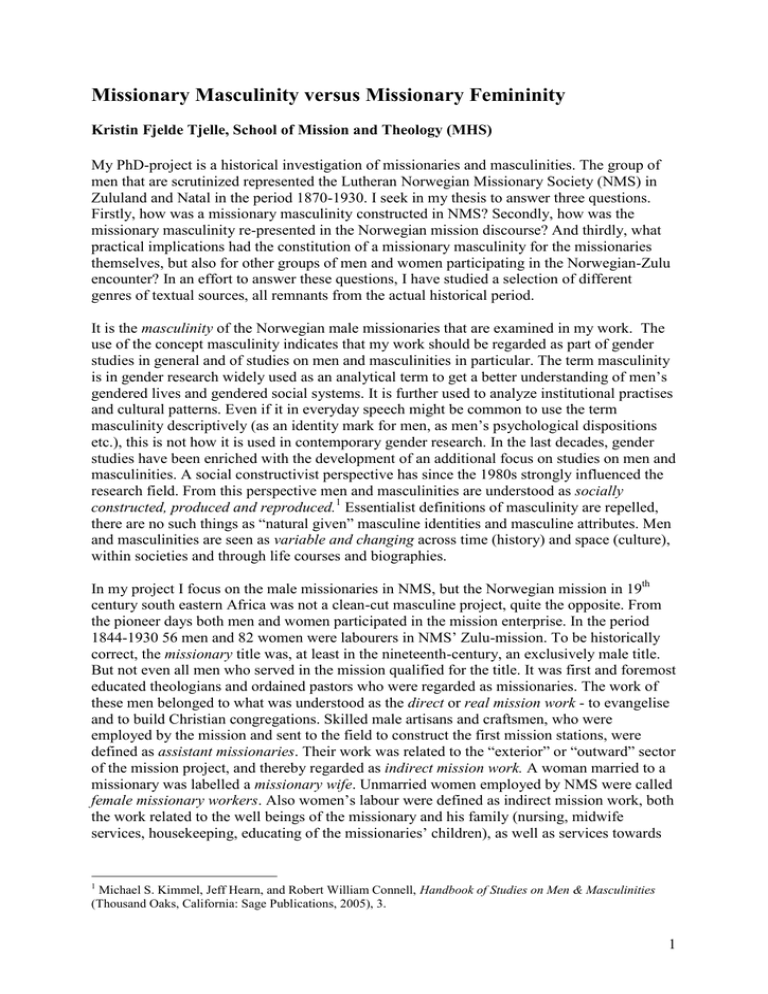
Missionary Masculinity versus Missionary Femininity Kristin Fjelde Tjelle, School of Mission and Theology (MHS) My PhD-project is a historical investigation of missionaries and masculinities. The group of men that are scrutinized represented the Lutheran Norwegian Missionary Society (NMS) in Zululand and Natal in the period 1870-1930. I seek in my thesis to answer three questions. Firstly, how was a missionary masculinity constructed in NMS? Secondly, how was the missionary masculinity re-presented in the Norwegian mission discourse? And thirdly, what practical implications had the constitution of a missionary masculinity for the missionaries themselves, but also for other groups of men and women participating in the Norwegian-Zulu encounter? In an effort to answer these questions, I have studied a selection of different genres of textual sources, all remnants from the actual historical period. It is the masculinity of the Norwegian male missionaries that are examined in my work. The use of the concept masculinity indicates that my work should be regarded as part of gender studies in general and of studies on men and masculinities in particular. The term masculinity is in gender research widely used as an analytical term to get a better understanding of men’s gendered lives and gendered social systems. It is further used to analyze institutional practises and cultural patterns. Even if it in everyday speech might be common to use the term masculinity descriptively (as an identity mark for men, as men’s psychological dispositions etc.), this is not how it is used in contemporary gender research. In the last decades, gender studies have been enriched with the development of an additional focus on studies on men and masculinities. A social constructivist perspective has since the 1980s strongly influenced the research field. From this perspective men and masculinities are understood as socially constructed, produced and reproduced.1 Essentialist definitions of masculinity are repelled, there are no such things as “natural given” masculine identities and masculine attributes. Men and masculinities are seen as variable and changing across time (history) and space (culture), within societies and through life courses and biographies. In my project I focus on the male missionaries in NMS, but the Norwegian mission in 19th century south eastern Africa was not a clean-cut masculine project, quite the opposite. From the pioneer days both men and women participated in the mission enterprise. In the period 1844-1930 56 men and 82 women were labourers in NMS’ Zulu-mission. To be historically correct, the missionary title was, at least in the nineteenth-century, an exclusively male title. But not even all men who served in the mission qualified for the title. It was first and foremost educated theologians and ordained pastors who were regarded as missionaries. The work of these men belonged to what was understood as the direct or real mission work - to evangelise and to build Christian congregations. Skilled male artisans and craftsmen, who were employed by the mission and sent to the field to construct the first mission stations, were defined as assistant missionaries. Their work was related to the “exterior” or “outward” sector of the mission project, and thereby regarded as indirect mission work. A woman married to a missionary was labelled a missionary wife. Unmarried women employed by NMS were called female missionary workers. Also women’s labour were defined as indirect mission work, both the work related to the well beings of the missionary and his family (nursing, midwife services, housekeeping, educating of the missionaries’ children), as well as services towards 1 Michael S. Kimmel, Jeff Hearn, and Robert William Connell, Handbook of Studies on Men & Masculinities (Thousand Oaks, California: Sage Publications, 2005), 3. 1 the indigenous people of a more “civilising” kind (health, education, industrial and agricultural services). The modern missionary movement of the nineteenth century engaged Protestant as well as Catholic women on a large scale in the United States, Britain and British ex-colonies such as Canada and Australia, continental Europe and the Nordic countries. Women played central roles at home as supportive fund-raisers and also as missionary agents in parts of the world which were defined as non-Christian. The first women in the “mission field” were the missionary wives. Their primarily task was to serve their husbands and families in respect to sexualities, childbearing, child-rearing, cooking, cleaning, sewing, gardening, keeping poultry and cattle. The missionary wives were not directly employed or commissioned by the missions, and they were not paid separate wages. Yet, they were considered as important resources in the mission, both as their husband’s soul mates and co-workers, but also in their own right. A second group of women in the field were the female missionary workers supposed to serve in the missionary households. The presence of female assistance within the missionary households was accepted and formalised in NMS from 1870.2 While the missionary wives and the female missionary workers by some scholars have been regarded as “peri-professional” missionaries, a third group - “the professional female mission worker” – arrived on the scene from the 1880s,3 and from 1887 NMS also formalised the use of women in the direct mission work as “Bible women”, teachers and deaconesses.4 By 1900, white women outnumbered men in most western missions, as wives, teachers, nurses and nuns. But according to the British historians Patrician Grishaw and Peter Sherlock, it was only from the 1980s that scholars focused gendered lens on the history of modern mission.5 Historians who have studied the relation between mission and women in a 2 Martha Nikoline Hirsch was in 1870 sent by NMS to South Africa as a first female missionary worker. She was commissioned to serve as a governess in the missionary families. 3 Rhonda Anne Semple, Missionary Women: Gender, Professionalism and the Victorian Idea of Christian Mission (Woodbridge: Boydell Press, 2003). 4 A NMS’ general assembly decision of 1887. 5 Patricia Grimshaw and Peter Sherlock, "Women and Cultural Exchanges," in Missions and Empire, ed. Norman Etherington (Oxford: Oxford University Press, 2005). In a review of the last decades’ research on women and mission Grishaw and Sherlock see three central developments. Firstly, American feminist historians with an interest in women and religion were the first to argue that the missionary enterprise had played a critical role in transforming the whole of society, and further that women were central historical agents in the mission movement. Central works have been Jane Hunter, The Gospel of Gentility: American Women Missionaries in Turn-of-the-century China (New Haven, Connecticut: Yale University Press, 1984); Patricia R. Hill, The World Their Household: The American Woman's Foreign Mission Movement and Cultural Transformation, 1870-1920 (Ann Arbor, MI: University of Michigan Press, 1985); Dana L. Robert, American Women in Mission: A Social History of their Thought and Practice (Macon, GA: Mercer University Press, 1997). Secondly, anthropologists and social historians, also in the 1980s, found missions to be interesting sites for observation and ethnographically historical studies of cultural conflicts and gender relations. Influential works in this category have been Diane Langmore, Missionary Lives: Papua, 1874-1914 (Honolulu: University of Hawai'i Press, 1989); Patricia Grimshaw, Paths of Duty: American Missionary Wives in Nineteenth-Century Hawaii (Honolulu: University of Hawai'i Press, 1989); Fiona Bowie, Deborah Kirkwood, and Shirley Ardner, eds., Women and Missions: Past and Present: Anthropological and Historical Perceptions (Oxford: Berg, 1993). Thirdly, since the late 1980s feminist scholars have been responded to post-colonial critiques questioning the role of white women as agents of mission enterprises, and mission archives have been used to explore the relation between gender, race and Empire. The influence of post-colonial studies is found in a number of recent works on women and mission: The influence of post-colonial studies is found in a number of recent works on women and mission: Antoinette Burton, Burdens of History: British Feminists, Indian women, and Imperial Culture, 1865-1915 (Chapel Hill, North Carolina: The University of North Carolina Press, 1994); Jayawardena Kumari, The White Woman's Other Burden: Western Women and South Asia during British Colonial Rule (New York/London: Routledge, 1995); Mary Taylor Huber and Nancy Lutkehaus, Gendered Missions: Women and 2 Norwegian context have been influenced by international research trends. Some have focused on the rise of a female missionary movement in Norway and its importance for the development of women’s democratic rights,6 others on female missionary agents,7 and others on cultural exchanges and the mission’s gendered organisation.8 The post-colonial challenge is reflected upon in a recent collection of essays on women and mission in a Nordic context.9 With this up-to-date and immense portfolio of research on women and mission, and further on missionary organisation’s gendered ideologies and practices, it would in my opinion be a huge mistake to not let my study of missionaries and masculinities reflect upon and respond to it. In a recent article the Norwegian sociologist and gender researcher Øystein Gullvåg Holter criticises the tendency in current research on men and masculinities “to marginalize women and femininities, and recreate men, manliness and masculinity as the big central issue”.10 It seems like a paradox that this tendency is found within a research field which is trying to abolish patriarchal logics of this kind. Holter explains the androcentrism (focus on men or men’s interests) in studies on men and masculinities partly as a historical reaction against a tendency of gynocentrism (focus on women and women’s interests) in feminist and women’s studies. In general, he finds a homosocial focus to be a tendency in any gender studies and asks for “a better integration of the gender equality dimension in the research framework of men and masculinities, including a more heterosocial focus and a greater awareness of implicit androcentrism”. In my research on missionary masculinity I hope to avoid this one-sided homosocial perspective, so brilliant observed by Holter. I aim to examine the relation between men and women within the organisational system of NMS in South Africa, likewise, how missionary masculinities were constructed in coherence and conflict with missionary femininities. Holter’s suggestive theoretical perspectives have further inspired me to try to avoid what he calls the “powercentric framework” so much used in masculinity studies.11 As an alternative, he describes a more materialistic approach where gender is “produced more than powered”. His point is that gender in/equality not necessarily is determined by gender alone, but that a Men in Missionary Discourse and Practice (Ann Arbor, MI: University of Michigan Press, 1999); Susan Thorne, Congregational Missions and the Making of an Imperial Culture in Nineteenth-century England (Stanford, California: Stanford University Press, 1999); Myra Rutherdale, Women and the White Man's God: Gender and Race in the Canadian Mission Field (Vancouver: UBC Press, 2002). 6 Kristin Fjelde Tjelle, "Kvinder hjælper Kvinder": Misjonskvinneforeningsbevegelsen i Norge 1860-1910 (Unpublished Ma thesis, University of Oslo, 1990); Kristin Norseth, "...at sætte sig imod vilde være som at stoppe Elven" (Unpublished Ma thesis, Menighetsfakultetet, 1997); Kristin Norseth, "La os bryte over tvert med vor stumhet!": Kvinners vei til myndighet i de kristelige organisasjonene 1842-1912 (Dissertation for the degree of Dr. Theol., MF Norwegian School of Theology, 2007); Bjørg Seland, "'Called by the Lord' - Women's Place in the Norwegian Missionary Movement," in Gender and Vocation. Women, Religion and Social Change in the Nordic Countries, 1830-1940, ed. Pirjo Markkola (Helsinki: Finnish Literature Society, 2000). 7 Lisbeth Mikaelsson, Kallets ekko: Studier i misjon og selvbiografi, vol. nr 17 (Kristiansand: Høyskoleforlaget, 2003); Inger Marie Okkenhaug, "Herren har givet mig et rigt virkefelt: Kall, religion og arbeid blant armenere i det osmanske riket," Historisk tidsskrift 88, no. 1 (2009). 8 Karina Hestad Skeie, "Building God's Kingdom: The Importance of the House to Nineteenth Century Norwegian Missionaries in Madagascar " in Ancestors, Power and History in Madagascar, ed. Karen Middlton (Leiden: Brill Academic Publishers, 1999); Line Nyhagen Predelli, Issues of Gender, Race, and Class in the Norwegian Missionary Society in Nineteenth-Century Norway and Madagascar (Lewiston, N.Y.: Edwin Mellen Press, 2003). 9 Inger Marie Okkenhaug, Gender, Race and Religion: Nordic Missions 1860-1940 (Uppsala: Swedish Institute of Missionary Research, 2003). 10 Øystein Gullvåg Holter, "Power and structure in studies of men and masculinities," Norma. Nordisk tidsskrift for maskulinitetsstudier 4, no. 2 (2009). 11 Ibid. 3 broader scope is needed. “The doing of gender” is structured also by non-gendered structures (ethnicity, age, class) and societal developments (development of welfare systems, extension of democratic rights, a general small/great extent of social in/equality, small/huge gap in income), and intersectionality as analytical lens is of greatest importance. In another essay by Holter, he asserts that one in gender research should distinguish between patriarchal structure, which he defines as the general character of the oppression of women and the linked oppression of non-privileged men within a given society and culture, and gender system, a partially independent and dynamic framework of meaning.12 A gender system is not simply an echo of the structures of inequality or patriarchy. It develops its own dynamics, sometimes acting on its own, often with tension and conflict-filled relations to patriarchal structures. The core idea of Holter is that we have to distinguish between patriarchal structure and gender system developments and then to look at the changing connections between them. NMS in South Africa was definitely a patriarchal system and in the period I have examined, 1870-1930, gender equality was out of question. Missionary women, as well as Zulu men and Zulu women in the Norwegian mission church, were subordinated the structural leadership and cultural hegemony of white male missionaries. Karin Sarja in her study of the missionary women in the Church of Sweden Mission in Zululand and Natal in the period 1876-1902, which resembles the case of NMS, found that women had to subordinate three levels of patriarchal structures; firstly, the central mission management at home, secondly, the missionary conference in the field and thirdly, the male missionary managing the mission station.13 Still, within these structures of patriarchy considerable changes found place in terms of gender in/equality. Line Nyhagen Predelli, in her study of NMS in Madagascar and Norway 1880-1910, speaks of “contested patriarchy” and “contested gender regimes”.14 Mission historians suppose a “feminisation of the mission forces” by late 19th century, both in terms of a surplus of women among the missionary recruits as well as a feminised mission philosophy – what Dana L. Robert calls “The Mission of Motherhood”.15 The cultural and theological attitude of the international women’s missionary movement at the beginning of the twentieth century was characterized by its motto “Woman’s work for woman”.16 With nineteenth-century assumptions that men and women occupied different roles in society, this gendered mission philosophy emphasized that it took women to reach other women and their children with the gospel. Behind the theory lay law middle-class, western assumptions, that western women needed to help liberate their sisters around the world by reaching them in their homes, teaching them to read, and providing medical care for their bodies. Conversion to Christianity provided not only eternal salvation for women, but it also raised their self-worth and improved their position in oppressive, patriarchal societies. In Norway, the woman’s missionary movement formulated its program in a similar way - “Women help women” 12 Øystein Gullvåg Holter, "Social Theories for Researching Men and Masculinities," in Handbook of studies on men & masculinities, ed. Michael S. Kimmel, Jeff Hearn, and R. W. Connell (Thousand Oaks, Calif.: Sage Publications, 2005). See also Øystein Gullvåg Holter, Män i rörelse: jämställdhet, förändring och social innovation i Norden (Stockholm: Gidlund, 2007). 13 Karin Sarja, "The Missionary Career of Baroness Hedvig Posse 1887-1913," in Gender, Race and Religion: Nordic missions 1860-1940, ed. Inger Marie Okkenhaug (Uppsala: Swedish Institute of Missionary Research, 2003). 14 Predelli, Issues of Gender, Race, and Class in the Norwegian Missionary Society in Nineteenth-Century Norway and Madagascar. 15 Dana L. Robert, Christian Mission: How Christianity became a World Religion (Chichester: Wiley-Blackwell, 2009), 124. 16 Dana L. Robert (ed.), Gospel Bearers, Gospel Barriers: Missionary Women in the Twentieth Century (Maryknoll, New York: Orbis Books, 2002), 7. 4 (Kvinder hjælper Kvinder).17 Resourceful and creative female mission leaders established female mission networks, organisations and institutions and they recruited female missionaries. They edited women’s mission magazines and wrote women’s mission books, and imported and implemented the central conceptions and ideologies of the international women’s missionary movement into a Norwegian context.18 How did the international woman’s missionary movement influence on NMS’ organisation in South Africa? What was the male reaction to this worldwide feminisation of the mission forces? In my research, I found that it took quite some time before the international program of woman’s work for woman was accepted by the male dominated management of NMS in South Africa. While professional female missionary workers in Madagascar could vote and speak at the missionary conferences from 1905,19 missionary women were first twenty years later, in 1924, given the same democratic rights in NMS in South Africa.20 It should be the professional work of missionary nurses which paved the way for men’s acceptance of women’s missionary work in NMS in South Africa. After the sudden interruption of Christian Oftebros’ career as a medical missionary in 1888, no physicians had been commissioned by NMS to South Africa. The missionaries had occasionally brought up he issue,21 as both the mission fields in Madagascar and China were well equipped with physicians, nurses, deaconesses and male deacons, and the construction of health institutions had been an area of priority.22 The issue of a medical mission in Zululand was an ongoing theme of negotiation between the missionary conference and NMS’ Home Board in the 1920s.23 While it was discussed whether NMS should recruit a female or male physician, where a possible hospital should be situated, and how extensive it’s services should be, two missionary nurses unnoticed established tiny hospitals at Ekombe and Mahlabatini mission stations.24 Elida Ulltveit-Moe was supposed to go to Madagascar as a missionary nurse but due to medical reasons transferred to South Africa in 1922. Since there were no hospitals in NMS’ mission in South Africa, the missionary conference appointed her to assist in the congregational work at Ekombe mission station.25 She arrived at Ekombe in December 1922 where she soon offered her medical services. The first equipment she purchased was a horse 17 Tjelle, "Kvinder hjælper Kvinder": Misjonskvinneforeningsbevegelsen i Norge 1860-1910. Lisbeth Mikaelsson, "'Kvinne, ta ansvar og ledelse i dine egne hender': Historien om Henny Dons," Norsk tidsskrift for misjon 56, no. 2 (2002); Kristin Norseth, "To alen av hvilket stykke? Tvillingsøstrene LMF og KMA i norsk, nordisk og internasjonalt perspektiv," in Ibid.; Kristin Fjelde Tjelle, "Lærerinnenes Misjonsforbund gjennom 100 år," in Ibid.; Okkenhaug, "Herren har givet mig et rigt virkefelt: Kall, religion og arbeid blant armenere i det osmanske riket." 19 Predelli, Issues of Gender, Race, and Class in the Norwegian Missionary Society in Nineteenth-Century Norway and Madagascar , 185-188. 20 Minutes from NMS’ Missionary Conference (MC) in South Africa 1924, Mission Archive (MS) – School of Mission and Theology (MHS). 21 See for instance minutes from MC 1911, MA-MHS, 19-25. 22 Ludvig Munthe, Venstrehandsmisjon?: Misjons legar på Madagaskar frå 1860-åra og ut hundreåret (Oslo: Luther forlag, 1985); Thor Strandenæs, "Misjonsdiakonien som kulturuttrykk i Kina: En tekst- og billeddokumentasjon fra Hunanprovinsen," in Misjon og kultur. Festskrift til Jan-Martin Berentsen, ed. Thor Strandenæs (Stavanger: Misjonshøgskolens forlag, 2006). 23 See minutes from MC 1921, MA-MHS, 26; MC 1922, 21; MC 1923, 18; MC 1925, 28-29; MC 1926, 55-64; MC 1927, 34-44; MC 1928, 88-96; MC 1929, 111-113; MC 1930, 46-49. See also NMS’ Home Board’s letter of answer to the missionary conference in South Africa 1926, 16-20 & 1928, 20-21, MA-MHS. 24 Today both hospitals, Nkonjeni and Ekombe hospitals, are managed by the KwaZulu-Natal Department of Health. See http://www.kznhealth.gov.za 25 Minutes from MC 1922, MA-MHS, 6 and NMS’ Home Board’s letter of answer to the missionary conference in South Africa 1922, 2. 18 5 to take her to patient-visits in the neighbouring homesteads.26 Eventually patients started to come to the mission station to receive medical care. In 1924 she opened a policlinic. A store room functioned as dispensary and two traditional Zulu huts were raised for the in-patients, who slept on straw mats.27 Ulltveit-Moe was in her labour very much supported by the missionary couple she lived together with, Peter Andreas R. Strømme and his wife Kirsten. Mrs. Strømme was a nurse herself, while Mr. Strømme in addition to his theological education had been trained as a deacon, actually a male nurse, at The Norwegian Deacon’s Home in the years 1893-1897.28 The activities quickly expanded, and in 1926 the mission hospital was visited by 3 200 patients.29 At this time Ulltveit-Moe was mentally and physically exhausted, and her female colleagues Margaretha Titlestad and Bertha Gilje, both wrote letters to a newly established “Female Nurses’ Missionary Association” (Sykepleierskenes Missionring - SMR) in Norway, begging them to recruit and financially support a missionary nurse in Zululand. SMR answered the Zulu-missionaries’ prayers and Borghild Magnussen became the organisation’s first representative in the mission field, an event which in SMR’s history has been described as “a milestone”.30 The interest for UlltveitMoe’s medical mission among supporters in Norway was growing, and she raised considerable funds for the purpose of a proper hospital at Ekombe. With the Home Board’s blessing, though not their grants, a tiny hospital building with five rooms was erected in 1929.31 Martha Palm started a similar hospital at Mahlabathini mission station in October 1925.32 She originally came to South Africa to work as a housekeeper at NMS’ Home for missionaries’ children in Durban in 1920, but applied in 1923 for an opportunity to serve as a missionary nurse. Her application was accepted, although no financial support for her new medical mission project was granted. As was the case with Ekombe mission hospital, funds were raised among supporters in Norway but also in the Scandinavian settler milieu in Durban. Also Palm was supported and encouraged by the missionary couple serving at Mahlabathini, Marie and Johan Kjelvei. She received her first patients in an old stable at the mission station, and a children’s room in Kjelvei’s house functioned as dispensary. Quite soon she was able to build a first simple hospital building containing of three rooms; one was admission-room, kitchen and dispensary, a second was for in-patients, and a third room was for Palm herself. After a year a new building for in-patients was raised, and also two traditional Zulu huts for accompanying family members. To a great extent the hospital functioned as a maternity ward. 26 Elida Fykse, Til Sydkorsets land. Studiebrev til norske gjenter og gutar fra misjonær Elida Fykse (Stavanger: Det norske misjonsselskaps Bibel- og misjonskurs pr. korrespondanse, 1946), vol. 3, 5-10. 27 Martha Palm, "Vår hospitalsvirksomhet," in Zulu. Evangeliets landvinning, ed. Johan Kjelvei (Stavanger: Det Norske Misjonsselskaps trykkeri, 1932). 28 Strømme was accepted as a student at NMS’ Mission School from 1997 and was ordained in 1903. According to the historian Gunnar Stave, several of the young men who were refused by NMS as missionary candidates in 1893 were recommended to apply for admission at the newly established institution (1890) for male deacons in Christiania. Strømme was probably one of them. Both the Mission School and the Deacon’s Home recruited their students among the same group of men; men from lower social classes who lacked higher education, but still had strong commitments to serve in church or mission. Gunnar Stave, Mannsmot og tenarsinn. Det norske Diakonhjem i hundre år (Oslo: Det Norske Samlaget, 1990), 105-106. 29 Minutes from MC 1927, MA-MHS, 15-17. 30 See Ingrid Wyller, Sykepleiernes Misjonsring S.M.R. 50 år (Oslo: Sykepleiernes Misjonsring 1971), 31-34. While Borghild Magnussen finished missionary courses in Oslo and midwife training in Edinburgh, LMF paid the salary for Bertha Nerø who from 1926 assisted Elida Ulltveit-Moe at Ekombe mission hospital. Magnussen served at Ekombe in the period 1929-1935 but established later NMS’ third mission hospital at Umphumulo in 1935. 31 NMT 84, no. 34 (1929): 267. 32 NMT 83, no. 19 (1928): 150; Palm, "Vår hospitalsvirksomhet"; Vesla Hafstad, The History of Nkonjeni Hospital Mahlabatini District, Kwa Zulu, South Africa: From 1925-1978 (Norway: Vesla Hafstad, 2000). 6 In 1927 Palm reported that she had received 2 049 patients in her policlinic and assisted 78 mothers with their deliveries. It is interesting to notice that the medical mission in Zululand entirely was run by female missionary nurses. It was only from the 1950s that NMS equipped their mission hospitals in South Africa with physicians, who then happened to be men.33 As mentioned, female missionary workers were finally accepted as members of the missionary conference in 1924, and simultaneously, a process which resulted in male missionaries’ expanded understanding of the nature of mission work evolved. Both the sectors of education and health, the traditional spheres of the female missionaries, were to a greater extent accepted as “real mission work” and defined as “direct mission work”. These processes were of course of importance for the women involved, but they also influenced on men’s missionary identities. Strømme as an example, educated both as a deacon and a pastor, had for years missed a focus of diaconia in mission, and he became an outstanding defender of Ulltveit-Moe’s and Palm’s medical missions. During a missionary conference discussion in 1924, he stated that he never had regretted that he became a missionary, but he regretted that he never became a medical missionary.34 He regarded it as a huge drawback for NMS’ Zulu-mission that doctor Christian Oftebro never had been replaced - “this is an unhealed wound in our mission”. According to Strømme, NMS had with its age long neglect of medical mission in Zululand “an old debt to pay”.35 By 1930, the medical mission in NMS’ Zulu-mission was established as a new and promising field. It was met with great interest among mission supporters in Norway and had called forth considerable fundraisings. It had further vitalized and inspired the missionary community as a whole. Also the central management of NMS had accepted medical mission as a new and important sector of the mission work in South Africa. Einar Amdahl, NMS’ secretary-general, provided a theological legitimization of the effort when he in NMS’ magazine Norsk Missionstidende explained to the readers why the hospital-work in South Africa was of great importance.36 Firstly, it was “charity work” in the name of Jesus Christ. The love of Christ urged us to practise these deeds of love. Secondly, it paved the way for the Gospel to “huts and hearts” that otherwise would be closed. Thirdly, the power of the “witchdoctors” was challenged and in many cases broken. This was of great importance also for the evangelising task. The Zulu people had a strong fear for evil spirits and supernatural enemies, he claimed, something which bound them to the traditional witchdoctors who was supposed to help in cases of sickness and health problems. Through the Christian nursing and medical care, people’s faith and trust in traditional healers was challenged. Amdal did not cite the nurse Martha Palm in his article. But in Palm’s constant and thorough defence of medical mission at several missionary conferences, he could have found declarations worth citing. As in one example from 1926: “To nurse is to do church work. Nursing goes hand in hand with the preaching of the gospel. Both leads people out of the darkness of heathenism”.37 To conclude, in this paper I argue that we as gender researchers in the field of men and masculinities should avoid a one-sided homosocial perspective and be aware of the dangers of 33 Ivar A. Andersen, "Sør-Afrika," in I tro og tjeneste. Det Norske Misjonsselskap 1842-1992, ed. Torstein Jørgensen (Stavanger: Misjonshøgskolen, 1992), 332-334. 34 Minutes from MC 1924, MA-MHS, 19. 35 Minutes from MC 1926, MA-MHS, 57. 36 Norsk Missionstidende 84, no. 10 (1929): 396. 37 Minutes from MC 1928, MA-MHS, 91: “Derfor blir sykepleien ogsaa et menighetsarbeide, som hand i hand med evangeliets forkyndelse i menighetene fører dem ut av hedenskapets mørke”. 7 andocentrism. Masculinity is never constructed in vacuum, and in gender studies we should be especially aware of how masculinity is constructed in relation to, in conflict as well as in correspondence to, constructions of femininity. In the case of NMS’ mission in South Africa, I have found that the arrival of professional female missionary workers - and the missionary nurses from early 1920s in particular – revitalised the mission activity as a whole, expanded male missionary’s understanding of the nature of mission, and influenced on their own missionary identities. In other words, constructions of missionary femininity had impact on constructions of missionary masculinity. Archival Sources NMS’ Mission Archive (MA), School of Mission and Theology (MHS) Norsk Missionstidende 1920-1930 Minutes from NMS’ Missionary Conferences in South Africa, 1920-1930 Literature and printed sources Andersen, Ivar A. "Sør-Afrika." In I tro og tjeneste. Det Norske Misjonsselskap 1842-1992, ed. Torstein Jørgensen. Stavanger: Misjonshøgskolen, 1992. Bowie, Fiona, Deborah Kirkwood, and Shirley Ardner, eds. Women and Missions: Past and Present: Anthropological and Historical Perceptions. Oxford: Berg, 1993. Burton, Antoinette. Burdens of History: British Feminists, Indian women, and Imperial Culture, 1865-1915. Chapel Hill, North Carolina: The University of North Carolina Press, 1994. Fykse, Elida. Til Sydkorsets land. Studiebrev til norske gjenter og gutar fra misjonær Elida Fykse. Vol. 1-3. Stavanger: Det norske misjonsselskaps Bibel- og misjonskurs pr. korrespondanse, 1946. Grimshaw, Patricia. Paths of Duty: American Missionary Wives in Nineteenth-Century Hawaii Honolulu: University of Hawai'i Press, 1989. Grimshaw, Patricia, and Peter Sherlock. "Women and Cultural Exchanges." In Missions and Empire, ed. Norman Etherington, 173-193. Oxford: Oxford University Press, 2005. Hafstad, Vesla. The History of Nkonjeni Hospital Mahlabatini District, Kwa Zulu, South Africa: From 19251978. Norway: Vesla Hafstad, 2000. Hill, Patricia R. The World Their Household: The American Woman's Foreign Mission Movement and Cultural Transformation, 1870-1920. Ann Arbor, MI: University of Michigan Press, 1985. Holter, Øystein Gullvåg. "Social Theories for Researching Men and Masculinities." In Handbook of studies on men & masculinities, ed. Michael S. Kimmel, Jeff Hearn and R. W. Connell. Thousand Oaks, Calif.: Sage Publications, 2005. Holter, Øystein Gullvåg. Män i rörelse: jämställdhet, förändring och social innovation i Norden. Stockholm: Gidlund, 2007. Holter, Øystein Gullvåg. "Power and structure in studies of men and masculinities." Norma. Nordisk tidsskrift for maskulinitetsstudier 4, no. 2 (2009): 133-145. Hunter, Jane. The Gospel of Gentility: American Women Missionaries in Turn-of-the-century China. New Haven, Connecticut: Yale University Press, 1984. Huber, Mary Taylor, and Nancy Lutkehaus. Gendered Missions: Women and Men in Missionary Discourse and Practice. Ann Arbor, MI: University of Michigan Press, 1999. 8 Kimmel, Michael S., Jeff Hearn, and R. W. Connell. Handbook of studies on men & masculinities. Thousand Oaks, Calif.: Sage Publications, 2005. Kumari, Jayawardena. The White Woman's Other Burden: Western Women and South Asia during British Colonial Rule. New York/London: Routledge, 1995. Langmore, Diane. Missionary Lives: Papua, 1874-1914. Honolulu: University of Hawai'i Press, 1989. Mikaelsson, Lisbeth. "'Kvinne, ta ansvar og ledelse i dine egne hender': Historien om Henny Dons." Norsk tidsskrift for misjon 56, no. 2 (2002): 107-137. Mikaelsson, Lisbeth. Kallets ekko: Studier i misjon og selvbiografi. Vol. nr 17. Kristiansand: Høyskoleforlaget, 2003. Munthe, Ludvig. Venstrehandsmisjon?: Misjon[s]legar på Madagaskar frå 1860-åra og ut hundreåret. Oslo: Luther, 1985. Norseth, Kristin. "...at sætte sig imod vilde være som at stoppe Elven". Unpublished Ma thesis, Menighetsfakultetet, 1997. Norseth, Kristin. "To alen av hvilket stykke? Tvillingsøstrene LMF og KMA i norsk, nordisk og internasjonalt perspektiv." Norsk tidsskrift for misjon 56, no. 2 (2002): 91-106. Norseth, Kristin. "La os bryte over tvert med vor stumhet!": Kvinners vei til myndighet i de kristelige organisasjonene 1842-1912. Dissertation for the degree of Dr. Theol., MF Norwegian School of Theology, 2007. Okkenhaug, Inger Marie. Gender, Race and Religion: Nordic Missions 1860-1940. Uppsala: Swedish Institute of Missionary Research, 2003. Okkenhaug, Inger Marie. "Herren har givet mig et rigt virkefelt: Kall, religion og arbeid blant armenere i det osmanske riket." Historisk tidsskrift 88, no. 1 (2009): 39-60. Palm, Martha. "Vår hospitalsvirksomhet." In Zulu. Evangeliets landvinning, ed. Johan Kjelvei. Stavanger: Det Norske Misjonsselskaps trykkeri, 1932. Predelli, Line Nyhagen. Issues of Gender, Race, and Class in the Norwegian Missionary Society in NineteenthCentury Norway and Madagascar. Lewiston, N.Y.: Edwin Mellen Press, 2003. Robert, Dana L. American Women in Mission: A Social History of their Thought and Practice. Macon, GA: Mercer University Press, 1997. Robert, Dana L. Christian Mission: How Christianity became a World Religion. Chichester: Wiley-Blackwell, 2009. Robert, Dana L., ed. Gospel Bearers, Gospel Barriers: Missionary Women in the Twentieth Century. Maryknoll, New York: Orbis Books, 2002. Rutherdale, Myra. Women and the White Man's God: Gender and Race in the Canadian Mission Field. Vancouver: UBC Press, 2002. Sarja, Karin. "The Missionary Career of Baroness Hedvig Posse 1887-1913." In Gender, Race and Religion: Nordic missions 1860-1940, ed. Inger Marie Okkenhaug, 104-153. Uppsala: Swedish Institute of Missionary Research, 2003. Seland, Bjørg. "'Called by the Lord' - Women's Place in the Norwegian Missionary Movement." In Gender and Vocation. Women, Religion and Social Change in the Nordic Countries, 1830-1940, ed. Pirjo Markkola. Helsinki: Finnish Literature Society, 2000. Semple, Rhonda Anne. Missionary Women: Gender, Professionalism and the Victorian Idea 9 of Christian Mission. Woodbridge: Boydell Press, 2003. Skeie, Karina Hestad. "Building God's Kingdom: The Importance of the House to Nineteenth Century Norwegian Missionaries in Madagascar " In Ancestors, Power and History in Madagascar, ed. Karen Middlton. Leiden: Brill Academic Publishers, 1999. Stave, Gunnar. Mannsmot og tenarsinn. Det norske Diakonhjem i hundre år. Oslo: Det Norske Samlaget, 1990. Strandenæs, Thor. "Misjonsdiakonien som kulturuttrykk i Kina: En tekst- og billeddokumentasjon fra Hunanprovinsen." In Misjon og kultur. Festskrift til Jan-Martin Berentsen, ed. Thor Strandenæs. Stavanger: Misjonshøgskolens forlag, 2006. Tjelle, Kristin Fjelde. "Kvinder hjælper Kvinder": Misjonskvinneforeningsbevegelsen i Norge 1860-1910. Unpublished Ma thesis, University of Oslo, 1990. Tjelle, Kristin Fjelde. "Lærerinnenes Misjonsforbund gjennom 100 år." Norsk tidsskrift for misjon 56, no. 2 (2002). Thorne, Susan. Congregational Missions and the Making of an Imperial Culture in Nineteenth-century England. Stanford, California: Stanford University Press, 1999. Wyller, Ingrid. Sykepleiernes Misjonsring S.M.R. 50 år. Oslo: Sykepleiernes Misjonsring 1971. 10
